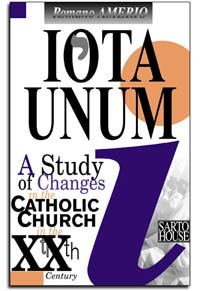

- Methodological and linguistic definitions.
- Denial of the crisis.
- The error of secondary Christianity.
- The crisis as failure to adapt.
- Adapting the Church's contradiction of the world.
- Further denial of the crisis.
- The Pope recognizes the loss of direction.
- Pseudo-positivity of the crisis. False philosophy of religion.
- Further admissions of a crisis.
- Positive interpretation of the crisis. False philosophy of religion.
- Further false philosophy of religion.
- The crises of the Church: Jerusalem (50 A.D.).
- The Nicene crisis (325 A.D.).
- The deviations of the Middle Ages.
- The crisis of the Lutheran secession. The breadth of the Christian ideal.
- Further breadth of the Christian ideal. Its limits.
- The denial of the Catholic principle in Lutheran doctrine.
- Luther's heresy, continued. The bull Exsurge Domine.
- The principle of independence and abuses in die Church.
- Why casuistry did not create a crisis in the Church.
- The revolution in France.
- The principle of independence. The Auctorem Fidei.
- The crisis of the Church during the French Revolution.
- The Syllabus of Pius IX.
- The spirit of the age. Alexander Manzoni.
- The modernist crisis. The second Syllabus.
- The pre-conciliar crisis and the third Syllabus.
- Humani Generis (1950).

CHAPTER III: The Preparation of The Council
- The Second Vatican Council. Its preparation.
- Paradoxical outcome of the Council.
- Paradoxical outcome of the Council, continued. The Roman Synod.
- Paradoxical outcome of the Council, continued. Veterum Sapientia.
- The aims of the First Vatican Council.
- The aims of Vatican II. Pastorality.
- Expectations concerning the Council.
- Cardinal Montini’s forecasts. His minimalism.
- Catastrophal predictions.
- The opening address. Antagonism with the world. Freedom of the Church.
- The opening speech. Ambiguities of text and meaning.
- The opening speech. A new attitude towards error.
- Rejection of the council preparations. The breaking of the council rules.
- The breaking of the Council’s legal framework, continued.
- Consequences of breaking the legal framework. Whether there was a conspiracy.
- Papal action at Vatican II. The Notapraevia.
- Further papal action at Vatican II. Interventions on mariological doctrine. On missions. On the moral law of marriage.
- Synthesis of the council in the closing speech of the fourth session. Comparison with St. Pius X. Church and world.
- Leaving the Council behind. The spirit of the Council.
- Leaving the Council behind. Ambiguous character of the conciliar texts.
- Novel hermeneutic of the Council. Semantic change. The word “dialogue.”
- Novel hermeneutic of the Council, continued. “Circiterisms.” Use of the conjunction “but.” Deepening understanding.
- Features of the post-conciliar period. The universality of the change.
- The post-conciliar period, continued. The New Man. Gaudium et Spes 30. Depth of the change.
- Impossibility of radical change in the Church.
- The impossibility of radical newness, continued.
- The denigration of the historical Church.
- Critique of the denigration of the Church.
- False view of the early Church.
- DE: http://www.sspxasia.com/Documents/books/Iota_Unum/index.htm

 inundado por um mistério de luz que é Deus e N´Ele vi e ouvi -A ponta da lança como chama que se desprende, toca o eixo da terra, – Ela estremece: montanhas, cidades, vilas e aldeias com os seus moradores são sepultados. - O mar, os rios e as nuvens saem dos seus limites, transbordam, inundam e arrastam consigo num redemoinho, moradias e gente em número que não se pode contar , é a purificação do mundo pelo pecado em que se mergulha. - O ódio, a ambição provocam a guerra destruidora! - Depois senti no palpitar acelerado do coração e no meu espírito o eco duma voz suave que dizia: – No tempo, uma só Fé, um só Batismo, uma só Igreja, Santa, Católica, Apostólica: - Na eternidade, o Céu!
inundado por um mistério de luz que é Deus e N´Ele vi e ouvi -A ponta da lança como chama que se desprende, toca o eixo da terra, – Ela estremece: montanhas, cidades, vilas e aldeias com os seus moradores são sepultados. - O mar, os rios e as nuvens saem dos seus limites, transbordam, inundam e arrastam consigo num redemoinho, moradias e gente em número que não se pode contar , é a purificação do mundo pelo pecado em que se mergulha. - O ódio, a ambição provocam a guerra destruidora! - Depois senti no palpitar acelerado do coração e no meu espírito o eco duma voz suave que dizia: – No tempo, uma só Fé, um só Batismo, uma só Igreja, Santa, Católica, Apostólica: - Na eternidade, o Céu!